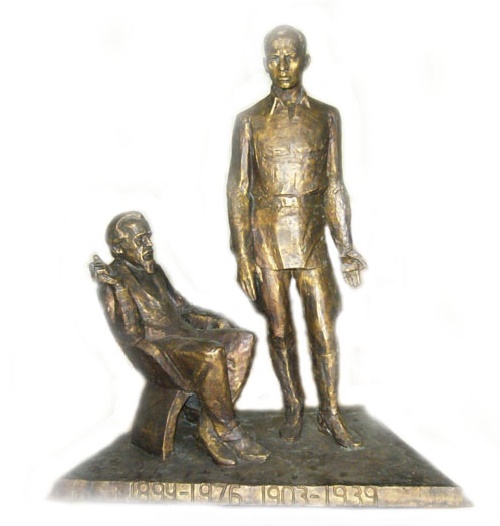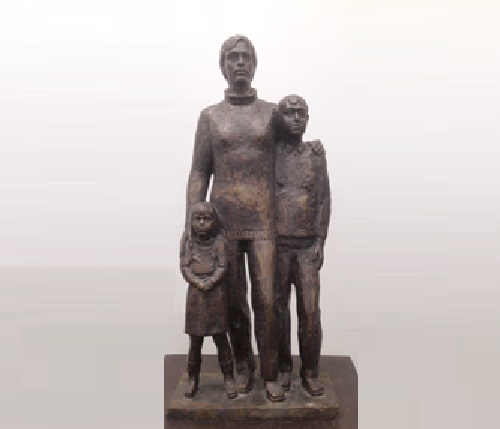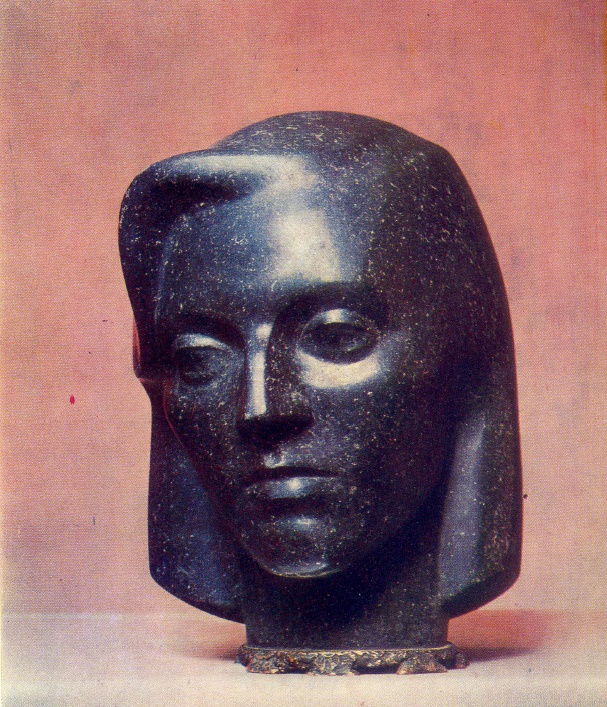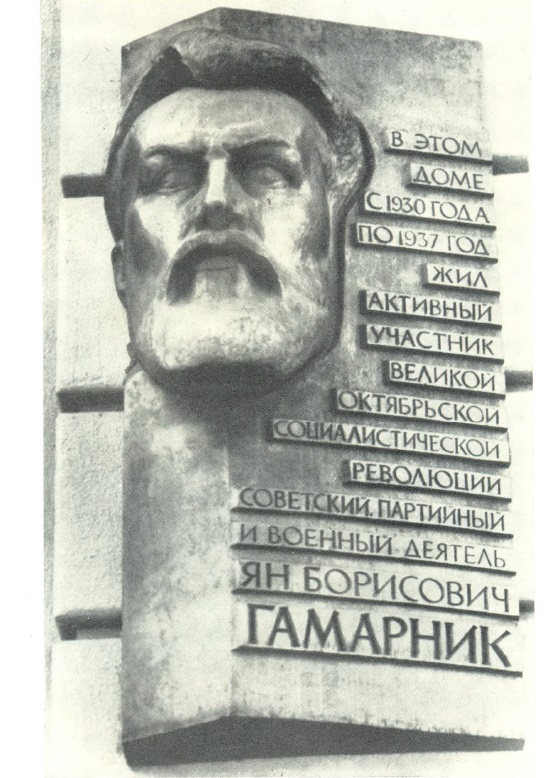Soviet sculptor Yuri Chernov 1935-2009

Yuri Gagarin (1934 – 1968). 1972. Copper, bronze. The State Tretyakov Gallery. Soviet sculptor Yuri Chernov
Soviet sculptor Yuri Chernov (1935-2009) – Academician of Russian Academy of Arts (1997, Corresponding Member of 1979), People’s Artist of the RSFSR (1979), Member of the USSR Union of Artists (1960), member of the Academy of Arts of Kyrgyzstan (1998). From 1977 to 1987 – Secretary of the USSR Union of Artists, awarded the Order of Friendship of Peoples, “Badge of Honor”. The most famous works – the monument to Yuri Gagarin in Moscow and Orenburg.
Yuri Chernov became an orphan early: in 1939, was arrested and killed his father, in 1944, his mother died. The true parental warmth and care, Yuri and his two brothers found in the family of their aunt Anna (elder sister of mother) and her husband Lev Chernov, who adopted the boys, brought up and led them to an independent way of life. Seeing Yuri’s capacity for modeling, he was sent to study at the Moscow Art School (now – Moscow State Art Lyceum), the sculpture department. Communicating with friends, visiting exhibitions, museums, and especially the Tretyakov Gallery, which was opposite the school in Lavrushinsky Lane, living in the atmosphere of art, friendship, respect for knowledge and work – shaped the identity of the future artist.

Yu L. Chernov (Moscow). Portrait of a Hero of Socialist Labor, foreman M. Chikh. 1980. Wrought copper, wood
In 1954, after graduating from school, Chernov entered the Moscow State Art Institute named after VI Surikov, where he studied in the studio of a major Soviet sculptor NV Tomsky. Regarding Tomsky, he built his pedagogical work combining rigor and credibility, integrity and great tact in the estimates, as much as possible trying to develop the talents of the individual characteristics of each student, to teach them to think plastically, starting from observations of life. He instilled in his students a love of Russian classics. Many useful tips for mastering the laws of sculpture gave to the students an assistant of NV Tomsky, an outstanding educator AA Drevin. From a young age Chernov considered his spiritual mentors AS Golubkina and ID Shadr.
In 1957-58, while still a student, Yuri Chernov began to participate in the Moscow youth exhibitions; for example, his works were exhibited in the all-Union exhibitions dedicated to the VI World Festival of Youth and Students in Moscow, and to the 40th anniversary of the Komsomol; in fact, they have been positively marked by criticism. In 1960 Chernov graduated from the Institute and a month later became the member of the USSR Union of Artists.
Notably, in search of new experiences, expanding ideas about the world, in 1961-1965 Chernov made a number of creative trips across the country and abroad. Along with O. Kiryukhin he visited Murmansk, made two trips to the Altai with O. Komov, visited the land of Novgorod and Pskov, the Baltic countries and the Far East, as well as Hungary, Germany, Greece. The results of these visits were extremely fruitful, as they gave the artist a wealth of material and have played an important role in his formation. At the art exhibitions of the 1960s, one after another, appeared new works of Chernov, sometimes combined in the series, such as “People of Zaonezhye”, and others. Chernov testified that he had found his theme, that is, his hero – the working man occupied with his favorite and at the same time usual work.
Indeed, works of Chernov of the 1960s dedicated to the theme of labor, brought the author fame as a kind of master of genre sculpture, moved apart borders of this type of plastic, as well as opened the way to great art. In 1968, he received award for participation in the All-Union exhibition “50 years of the Komsomol”, and in 1970 awarded the title of Honored Artist of the RSFSR.
Actually, over the years, the range of creative interests of sculptor becomes wider, it covers all the new themes and characters born in bright life experiences and feelings. Master boldly experiments in various types of sculpture, for instance, carried away with the problem of portrait and sculpture of small forms. He tried his hand in monumental art, participating in competitions, and created a lot of sketches from nature. Often, starting to work on sketches, Chernov takes it to such point of plastic and shaped completeness, that it becomes important independent artistic work (“The Girl with the cloth”, “Holiday”, “The Mirror”, “Morning”, “Day”, “Evening” and others).
Speaking about the inspiration, for Yury Chernov throughout his journey in the art the main source of inspiration was a man as the highest standard of ethical and aesthetic ideal. Sculptor is attracted with the courageous, challenging fate of men, men of honor and duty, faithful to their convictions. No accident that among the heroes of Chernov AM Gorky and LN Tolstoy, ID Shadr and MP Mussorgsky, Alexander Nevsky and Yuri Gagarin …
Careful attention to the man, the desire to penetrate into his inner world, to comprehend the nature in all its complexity led to a deep interest of Chernov in the work on portrait. Among the first of his works in this genre – the images of relatives and friends (portraits of his daughter and wife Katya and Inna Chernova, Leonid Chernov). The subtle insight into character, surprising warmth and softness distinguish these portraits. The image of a person of high moral qualities is recreated in the portrait of LI Chernov – the sculptor’s father.
With experience, finding professional freedom, Chernov poses an increasingly difficult task. He refers to the group portrait, performs a variety of portrait compositions. Such works of Chernov as “Father and Sons”, “Self-portrait with daughter,” “Portrait of GA Ilizarov”, “sculptor T. Sadykov in the new studio,” “Time is running (in the circle of friends)”, “young artist”, “Yuri Senkevich”, “Olympic champion Kapitonov”, and others. Thus, with these portraits the author raises important social, philosophical and ethical issues – awareness of the place of each individual in modern life, fidelity to the vocation, relationships and continuity of generations.
In 1978, for his work “Dr. Ilizarov” (1969), “Yuri Gagarin” (1977), “The Poet and the geologist E. Portnyagin” (1976) and “Ivan Shadr” (1977) Yuri Chernov was awarded the silver medal of the Academy of Arts of the USSR.
1970-80-ies – the time of active work of Yuri Chernov on monumental works (most of them created in collaboration with the architect G. Isaakovich, with whom Chernov had fruitfully worked for many years). The sculptor constructed a great number of monuments, including monuments to T. Maltsev (1983) in the village of Maltsevo of Kurgan region, and Krasin in Kurgan (1978), N. Shvernik (1979) and M. Keldysh (1981) in Moscow, A. Gorky in Frunze (1981), I. Shadr in Shadrinsk (1984), Alexander Nevsky in Novgorod (1985), IV Babushkin in Vologda (1987), PE Dybenko in Novozybkov of Bryansk region (1987), LN Tolstoy in Tula region (1988), and Nansen in Spitak (1989, Armenia). Additionally, during these years, Chernov was working enthusiastically on the image of the first cosmonaut Yuri Gagarin: designing monuments for Moscow (1985) and Orenburg (1986).
Soviet sculptor Yuri Chernov is the author of more than 20 plaques to outstanding people of national history, culture, science, and is now recognized as one of the most significant sculptor in this area. As an illustration, plaques of SY Marshak, GK Ordzhonikidze, YB Gamarnik VV Kuibyshev, SA Chuikov, DD Shostakovich, YB Levitan, AI Raikin, KI Chukovsky, and MP Mussorgsky. Yuri Chernov is also the author of tombstones of LP Orlova, LA Ruslanova and VV Kryukov, LO Utyosov, EK Katulskaya, VP Barmina, VS Alkhimova, AI Chernyshev and several others.
Since 1957 Soviet sculptor Yuri Chernov – a permanent participant in all major art exhibitions of the country, many foreign exhibitions; his work has been featured in a number of solo exhibitions. The best works of the sculptor are now in the collections of the State Tretyakov Gallery (42 works), the State Russian Museum, dozens of art museums in Russia and other countries.
Soviet sculptor Yuri Chernov

Detail of Monument to the soldiers citizens of Arkhangelsk, who died in the Second World War. 1970. Bronze

Doctor of Medical Sciences, Director of the Kurgan Research Institute of Experimental and Clinical Orthopedics and Traumatology G.A. Ilizarov. 1975. Forged copper
Sources:
Soviet Artist magazine
OMS Newspaper (Moscow Union of artists), August 2015
Soviet sculpture, illustrated album 1986






































































